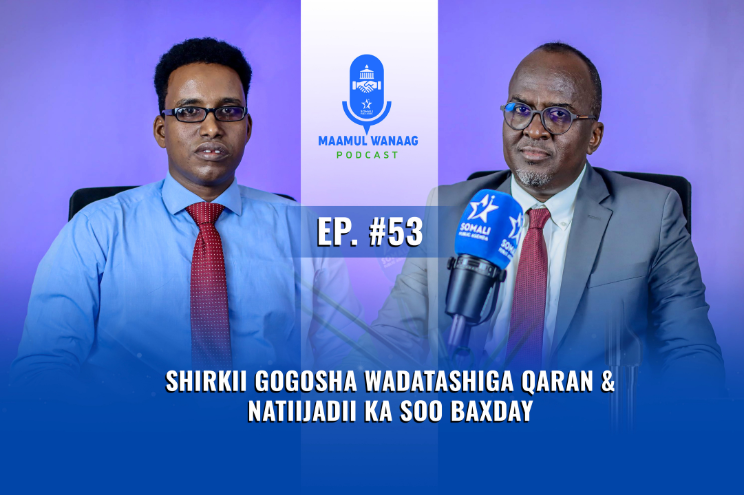Somali Public Agenda
February 27, 2022
Commentary
Somali Public Agenda
February 27, 2022

Mogadishu is often described as ‘the world’s most dangerous city’ by foreign observers, journalists, and pundits. This label captures the general sense of insecurity that has plagued the Somali capital for over three decades. There have been various complex elements influencing (the lack of) security in the city, and most of them have evolved over the years.
In the early 1990s, militia groups led by warlords, gunmen from rival clans, and freelance bandits have been the sources of insecurity. The Islamic Courts Union (ICU) displaced the warlords from the scene in the mid-2000s and the hopes were raised for lasting security improvements in the city. However, since then new security threats have emerged such as assassinations, roadside bomb blasts, car bombings, suicide bombers, and complex attacks against hotels or Government facilities.
Although all Mogadishu residents face security threats, in recent years, the security of particular segments of society and certain neighborhoods within the city have been given disproportionate consideration. At the same time, other parts of the society and their neighborhoods have rarely had their security issues and need to be taken into account. This commentary borrows from Immanuel Wallerstein’s ‘’World System Theory” – in which he divides the world into “core, semi-periphery, and periphery countries” and uses these terms to describe dramatically different security experiences and concerns across three distinct zones in Mogadishu.
Only certain segments of the society in Mogadishu (and their neighborhoods) tend to come to observers’ minds when they think about security issues/protections. These are the neighborhoods that may be regarded as the ‘’core’’ of the city and are often a target of terror threats. Security issues in this zone tend to attract local and international media attention. Aside from this core, the rest of the city’s people and places may be considered the “semi-periphery” and “periphery”. The rest of this commentary explains who tends to live in these distinct zones and the different security conditions and protections that they experience.
The “core’’ refers to the areas around the presidential palace and neighborhoods surrounding the airport. It is locally known as the ‘safe’ or ‘green zone’, where top government officials, politicians, foreign officials, senior government, UN, and other NGO employees reside. It is regarded as a safe zone because it is heavily guarded and protected from security threats. However, most of the middle class or ordinary citizens, for that matter, cannot afford to reside inside the area due to the land prices, rental fee, and standard of living in the area being exceptionally high.
The “semi-periphery’’ can be considered a semi-safe zone, where mid-level government and NGO employees reside. These areas are districts around Maka Al-Mukarama Street. It is more secure than the peripheral areas because the government has a wide-ranging security presence in these parts of the city. As a result, the more the area is felt to be safe, the more the living standard gets higher, as do the costs of living in this zone. This constitutes a form of gentrification, and many ordinary people and low-income families find it challenging to live here and are pushed out to the periphery.
The periphery, locally known to be unsafe, is where even government low-ranking employees and NGO employees are limited visiting, let alone residing in. This area is categorized as unsafe because government services, especially security services, are limited. In addition, some local government personnel responsible for those areas do not even live there due to security concerns. The outlying districts beyond Wadnaha Street are regarded as the periphery zone.
What is observed as daily security issues are different from the perspectives of the people living in the core, semi-periphery, and periphery areas. For instance, an ordinary person who lives in the periphery worries more about his/her belongings such as mobile phones and laptops being robbed by militias or gunmen wearing government military uniforms than being a target of assassination.
I asked more than fifty university students living in certain periphery areas, such as Heliwaa, Kaaraan, Wadajir, and Dharkenley districts, what they viewed as the primary security threat when commuting between the university and their residence. Most highlighted the armed men wandering around the streets who steal mobile phones or laptops. Besides this, organized teenage gangs targeting each other with stones or knives constitute a significant threat to the security of the ordinary people living in some of the periphery areas. Another recurrent security challenge in some of these peripheral areas is illegal roadblocks manned by armed groups dressed in military uniforms who extort money from public transportation, business, and residential places.
The government’s highly protected compounds are predominantly based in the semi-periphery zone. The zone is significantly overcrowded with people and private and public vehicles. This is due to the area’s relative security. People with purchasing power mostly prefer to live here; and the city’s popular cafes, restaurants, hotels, and universities are situated in this zone.
For these areas, major security concern is the occasional car bomb explosions or suicide bombers that target government headquarters and sometimes hotels, marketplaces, and restaurants. Indeed, the civilian population who live in the semi-periphery neighborhoods face similar or higher threats than their neighbors living in the peripheral areas – but incidents of robbery and extortion are less frequent in the semi-peripheral parts of Mogadishu compared to the city’s margins. While car bomb explosions or suicide bombers occasionally strike in the semi-periphery areas, they rarely occur and cause security threats in the periphery. However, explosions in the periphery are not given the same attention as those in the semi-periphery. This can be observed in the government’s reaction, the mass and social media mainstream discourses, and the ordinary people’s feedback on explosions in the periphery.
The victims of the periphery zone’s car or suicide explosions are much less visible than those in the semi-periphery because they are not high-ranking government employees or from any other well-known institutions, nor are they vocal or represented on social media. This reflects how the city’s security has been designed over the past few years and the prioritization of certain segments of the society and areas.
However, security threats have recently been growing in the semi-periphery zone that involve government soldiers. The roads in this zone are often purposefully blocked with stones and only highways with several security checkpoints are allowed to be open by the government to prevent potential security threats. The remaining streets are congested with traffic and angry soldiers sometimes use live ammunition to open the jammed streets, resulting in casualties.
The core area is considered the safe zone due to its heavy and costly protection. There are only a few streets through which vehicles and people can enter the zone. Therefore, it is rare for the people in the safe zone to confront the kind of security threats prevalent in the other two areas. The inhabitants from the safe zone mainly feel a security threat when they enter the semi-safe and unsafe zones, which they rarely go to without the protection of a heavily armed convoy.
Consequently, the frequency and local views of security threats in Mogadishu vary by a large degree. For unsafe zones, their everyday worries about security matters are not considered as an existential security threat that is prioritized by the government. The semi-safe zone is exposed to both types of security threats prevalent in the core and the periphery of the capital. Nonetheless, it is safer than the periphery because it enjoys the provision of a greater deal of government security services and obtains plenty of attention from mass and social media. The core or the safe zone is served by the main security apparatus of the government and the protection of the African Union (AU) forces, as well as local and foreign private security companies. Despite all this protection from various sources and stringent safety, a single security incident in the safe zone is met with nationwide media attention – while insecurity in the periphery is often ignored.
On the whole, Mogadishu’s security policy is designed to serve the needs of the core and semi-periphery areas while the periphery is neglected. Government security measures typically focus on the new security threats — car bomb explosions or suicide bombers — that have emerged in the last decade. These security threats mainly target the core and semi-periphery areas rather than the more mundane security threats in the periphery zone. Therefore, a comprehensive city-wide security strategy should reflect the needs of all of Mogadishu’s inhabitants. Acknowledging the existence of different types of security threats in the three zones should be used as starting point to reformulate the city’s security policy. A helpful approach can be enlarging the scope of the training, orientations, and guidelines of security forces that predominantly focus on dealing with terror threats.
The police stations in the periphery and semi-periphery areas need to deal with those who extort money from the businesses and residential places in the name of the government armed forces. They should also deal with organized groups of teenagers killing or hurting themselves or ordinary people. Were the police to extend its power to take action on these groups by arresting, putting them on trial for their crimes, their harms to society would be reduced
The semi-safe zone is safer than the periphery not only because of the provision of government security but because many people in society are either security or civilian officers in the government. Thus, they have access to raise their concerns over security threats or use their power if the authority does not respond to their concerns immediately.
In the relatively insecure peripheral neighborhoods, however, the security officials do not frequently respond to people’s concerns and these areas are not home to those who would have more influence in wider society. Therefore, it is imperative to reconsider the security concerns from all zones, particularly the periphery.
Finally, how the overall security policy is devised should be revised and redesigned to reflect the security demands of all people who live in each of the three zones. It is time for both the Somali government and international community to:
Aweis Ahmed is the director of SPA Center for Public Policy and Service Design.



Somali Public Agenda is a non-profit public policy and administration research organization based in Mogadishu. Its aim is to advance understanding and improvement of public administration and public services in Somalia through evidence-based research and analysis.
Stay updated on governance and public services in Somalia!
On my point view this is what really exist.
The most important is security
Core is better than periphery and periphery is better than semi periphery